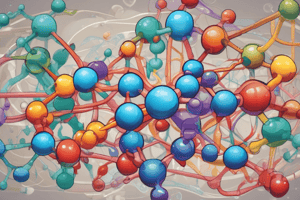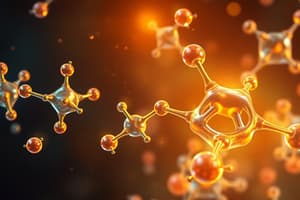Podcast
Questions and Answers
What process breaks down polymers?
What process breaks down polymers?
- Oxidation
- Hydrolysis (correct)
- Isomerization
- Dehydration synthesis
Which of the following is NOT a main category of large biological molecules?
Which of the following is NOT a main category of large biological molecules?
- Lipids
- Vitamins (correct)
- Proteins
- Carbohydrates
Which of the following best describes monosaccharides?
Which of the following best describes monosaccharides?
- Simple sugars that cannot be broken down into smaller units (correct)
- Large molecules used for structural support
- Double sugars formed by two monosaccharides
- Polymers of sugars
Glucose and fructose possess the same molecular formula yet differ in structure. This makes them:
Glucose and fructose possess the same molecular formula yet differ in structure. This makes them:
How are cells able to use glucose as a fuel source?
How are cells able to use glucose as a fuel source?
Which of the following is formed by linking two glucose molecules?
Which of the following is formed by linking two glucose molecules?
Which disaccharide is commonly known as 'milk sugar'?
Which disaccharide is commonly known as 'milk sugar'?
What type of reaction joins monosaccharides to form disaccharides?
What type of reaction joins monosaccharides to form disaccharides?
What is the primary characteristic that allows carbon to form a wide variety of complex molecules?
What is the primary characteristic that allows carbon to form a wide variety of complex molecules?
Which of the following best describes functional groups in organic compounds?
Which of the following best describes functional groups in organic compounds?
What is the role of a dehydration reaction in forming polymers?
What is the role of a dehydration reaction in forming polymers?
How might a cell use a hydrolysis reaction?
How might a cell use a hydrolysis reaction?
What is a characteristic of a macromolecule?
What is a characteristic of a macromolecule?
Which of the following is a true statement about methane (CH4)?
Which of the following is a true statement about methane (CH4)?
What is the relationship between monomers and polymers?
What is the relationship between monomers and polymers?
Which of these functional groups is commonly found in alcohols?
Which of these functional groups is commonly found in alcohols?
What is the primary function of starch in plants?
What is the primary function of starch in plants?
Why can't humans digest cellulose?
Why can't humans digest cellulose?
What is the primary purpose of carbo-loading for athletes?
What is the primary purpose of carbo-loading for athletes?
What is the main difference between starch and glycogen?
What is the main difference between starch and glycogen?
Which of the following best describes high-fructose corn syrup (HFCS)?
Which of the following best describes high-fructose corn syrup (HFCS)?
What is the role of dietary fiber in human nutrition?
What is the role of dietary fiber in human nutrition?
Which of these monomers is common to both starch and cellulose?
Which of these monomers is common to both starch and cellulose?
What is a primary function of mucus secretion in the digestive tract?
What is a primary function of mucus secretion in the digestive tract?
How do lipids differ from other macromolecules like carbohydrates and proteins?
How do lipids differ from other macromolecules like carbohydrates and proteins?
A typical fat molecule, also known as a triglyceride, is composed of which two main components?
A typical fat molecule, also known as a triglyceride, is composed of which two main components?
What distinguishes saturated fats from unsaturated fats at a molecular level?
What distinguishes saturated fats from unsaturated fats at a molecular level?
Which of the following is a primary characteristic of unsaturated fats at room temperature?
Which of the following is a primary characteristic of unsaturated fats at room temperature?
What process is used to convert unsaturated fats into saturated fats, and why is it done?
What process is used to convert unsaturated fats into saturated fats, and why is it done?
What are trans fats concerning hydrogenation, and what is their primary health implication?
What are trans fats concerning hydrogenation, and what is their primary health implication?
How does the structure of steroids differ from that of fats?
How does the structure of steroids differ from that of fats?
Which of the following is a key function of cholesterol in the human body?
Which of the following is a key function of cholesterol in the human body?
What is the primary reason anabolic steroids are sometimes prescribed by doctors?
What is the primary reason anabolic steroids are sometimes prescribed by doctors?
What characteristic of amino acids distinguishes one from another?
What characteristic of amino acids distinguishes one from another?
What type of bond is formed when two amino acids are joined together?
What type of bond is formed when two amino acids are joined together?
What is the function of transport proteins?
What is the function of transport proteins?
Anabolic steroid abuse is NOT associated with which of the following health problems?
Anabolic steroid abuse is NOT associated with which of the following health problems?
What process is used by cells to link amino acid monomers to form proteins?
What process is used by cells to link amino acid monomers to form proteins?
The unique three-dimensional shape of a protein is most directly related to its:
The unique three-dimensional shape of a protein is most directly related to its:
What is the direct relationship between a polypeptide and a protein?
What is the direct relationship between a polypeptide and a protein?
If a protein loses its specific three-dimensional shape, what is the most direct result?
If a protein loses its specific three-dimensional shape, what is the most direct result?
How do prions cause brain disorders?
How do prions cause brain disorders?
Within DNA, what determines the sequence of amino acids in a polypeptide?
Within DNA, what determines the sequence of amino acids in a polypeptide?
Which of the following is not a component of a nucleotide?
Which of the following is not a component of a nucleotide?
What is the role of hydrogen bonds in DNA?
What is the role of hydrogen bonds in DNA?
In DNA, which base always pairs with guanine (G)?
In DNA, which base always pairs with guanine (G)?
What is the relationship between a chromosome and a gene?
What is the relationship between a chromosome and a gene?
Flashcards
Organic Compounds
Organic Compounds
Molecules primarily made of carbon, often bonded to hydrogen, oxygen, and nitrogen.
Methane (CH4)
Methane (CH4)
A simple organic compound with one carbon atom bonded to four hydrogen atoms, abundant in natural gas.
Functional Groups
Functional Groups
Specific groups of atoms in organic compounds that influence chemical reactions and properties.
Hydroxyl Group (-OH)
Hydroxyl Group (-OH)
Signup and view all the flashcards
Carboxyl Group (-COOH)
Carboxyl Group (-COOH)
Signup and view all the flashcards
Macromolecules
Macromolecules
Signup and view all the flashcards
Dehydration Reaction
Dehydration Reaction
Signup and view all the flashcards
Hydrolysis
Hydrolysis
Signup and view all the flashcards
Biological Molecules
Biological Molecules
Signup and view all the flashcards
Carbohydrates
Carbohydrates
Signup and view all the flashcards
Monosaccharides
Monosaccharides
Signup and view all the flashcards
Isomers
Isomers
Signup and view all the flashcards
Disaccharides
Disaccharides
Signup and view all the flashcards
Lactose
Lactose
Signup and view all the flashcards
Maltose
Maltose
Signup and view all the flashcards
Sucrose
Sucrose
Signup and view all the flashcards
High-fructose corn syrup (HFCS)
High-fructose corn syrup (HFCS)
Signup and view all the flashcards
Starch
Starch
Signup and view all the flashcards
Glycogen
Glycogen
Signup and view all the flashcards
Carbo-loading
Carbo-loading
Signup and view all the flashcards
Cellulose
Cellulose
Signup and view all the flashcards
Dietary fiber
Dietary fiber
Signup and view all the flashcards
Polysaccharides
Polysaccharides
Signup and view all the flashcards
Cholesterol
Cholesterol
Signup and view all the flashcards
Anabolic Steroids
Anabolic Steroids
Signup and view all the flashcards
Amino Acids
Amino Acids
Signup and view all the flashcards
Polypeptide
Polypeptide
Signup and view all the flashcards
Peptide Bond
Peptide Bond
Signup and view all the flashcards
Enzymes
Enzymes
Signup and view all the flashcards
Structural Proteins
Structural Proteins
Signup and view all the flashcards
Protein Shape
Protein Shape
Signup and view all the flashcards
Lipids
Lipids
Signup and view all the flashcards
Triglyceride
Triglyceride
Signup and view all the flashcards
Saturated Fats
Saturated Fats
Signup and view all the flashcards
Unsaturated Fats
Unsaturated Fats
Signup and view all the flashcards
Hydrogenation
Hydrogenation
Signup and view all the flashcards
Trans Fats
Trans Fats
Signup and view all the flashcards
Omega-3 Fatty Acids
Omega-3 Fatty Acids
Signup and view all the flashcards
Protein
Protein
Signup and view all the flashcards
Sickle-Cell Disease
Sickle-Cell Disease
Signup and view all the flashcards
Prions
Prions
Signup and view all the flashcards
Nucleic Acids
Nucleic Acids
Signup and view all the flashcards
DNA
DNA
Signup and view all the flashcards
Nucleotides
Nucleotides
Signup and view all the flashcards
Base Pairing in DNA
Base Pairing in DNA
Signup and view all the flashcards
Study Notes
Lactose Intolerance
- Lactose intolerance is the inability to digest lactose, the main sugar in milk.
- Digestive cells in the small intestine produce lactase, an enzyme that breaks down lactose.
- After about age 2, lactase levels in most people decline significantly.
- Undigested lactose passes into the large intestine, where bacteria ferment it, causing bloating, gas, and abdominal pain.
- Avoidance of lactose-containing foods is one treatment option.
- Substitutes like soy or almond milk, or lactase-treated cow's milk, are alternatives.
- Lactase pills can be taken with food to aid digestion.
Carbohydrates
- Carbohydrates, also known as "carbs," are sugars and their polymers.
- Monosaccharides are simple sugars; examples are glucose and fructose.
- Glucose and fructose have the same chemical formula (C₆H₁₂O₆) but different structures, thus affecting how they react with other molecules.
- Monosaccharides commonly form ring structures in water.
- Glucose is a primary fuel source for cellular processes.
- Disaccharides are formed from two monosaccharides via dehydration reactions.
- Examples include lactose (glucose + galactose) and sucrose (glucose + fructose).
- Polysaccharides are complex carbohydrates formed by multiple sugar monomers.
- Common types include starch (storage in plants), glycogen (storage in animals), and cellulose (structural component in plants).
Lipids
- Lipids are hydrophobic molecules, not typically polymers.
- Fats (triglycerides) are composed of a glycerol molecule and three fatty acid molecules.
- Fatty acids are long chains that store lots of energy.
- Saturated fatty acids have no double bonds in their carbon chain, often solid at room temperature.
- Unsaturated fatty acids have one or more double bonds, often liquid at room temperature.
- Polyunsaturated fats have multiple double bonds.
- Steroids are a type of lipid with a four-ring structure.
- Cholesterol is a crucial component of cell membranes and a precursor for other steroids.
- Anabolic steroids are synthetic variants of testosterone, used for muscle growth but can be harmful.
Proteins
- Proteins are polymers of amino acids.
- They are essential workers in cells, with many structures and functions.
- Amino acids are differentiated by their side chains (R-groups).
- Polypeptide chains fold into complex 3-D shapes to perform their specific functions.
- The amino acid sequence determines the protein's shape and function.
- Misfolded proteins are implicated in some diseases.
Nucleic Acids
- Nucleic acids (DNA and RNA) store genetic information.
- DNA is a double helix with nucleotides containing deoxyribose sugar, phosphate, and one of four bases (A, T, C, G).
- RNA is usually single-stranded with nucleotides containing ribose sugar, phosphate, and one of four bases (A, U, C, G).
- The sequence of bases in DNA carries genetic instructions.
Studying That Suits You
Use AI to generate personalized quizzes and flashcards to suit your learning preferences.




